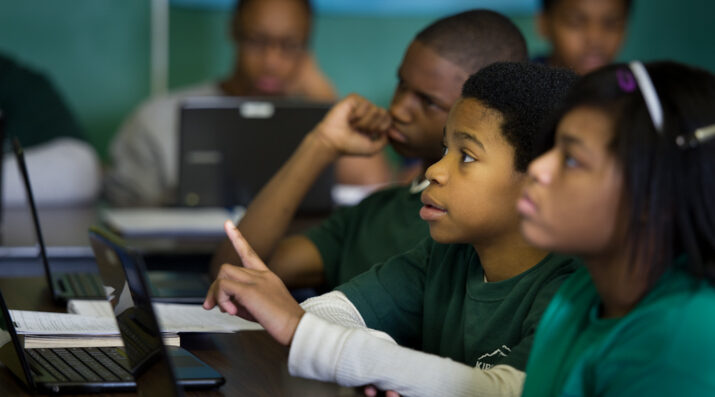Da Vinci Schools
HS integrates online learning, dynamic project-based learning, college courses & internships ...

We’ve all had the experience of truly purposeful, authentic learning and know how valuable it is. Educators are taking the best of what we know about learning, student support, effective instruction, and interpersonal skill-building to completely reimagine schools so that students experience that kind of purposeful learning all day, every day.
NGLC hopes to seed new models that result in higher learning outcomes and have the potential for scale. These new models take the best of what we know about learning, student support, and effective pedagogy to create completely reimagined schools.
Our investments in New Designs for School include two waves of Breakthrough School Models for College Readiness grants and the Regional Funds for Breakthrough Schools. NGLC aims to spur innovation that personalizes each student’s learning experience, ultimately reversing stagnant academic progress and an unacceptable achievement gap among K-12 students.
NGLC recognizes both a design problem and a cost problem in K-12 education, which is leading to disengagement and unacceptable dropout rates. First, the prevailing school model largely reflects a century-old factory model that has become a "one-size-fits-none" strategy. Because every learner starts with different strengths and weaknesses and progresses at different rates, teachers often struggle to meet the needs of today’s diverse student population, including low-income students and students of color.
Another problem is cost structure: many of the most successful school models are not sustainable on recurring public revenue, relying on nonrecurring public grants, private philanthropy, and other limited sources of capital to fund ongoing operations and growth.
Some emerging school models suggest that technology can facilitate a more student-centric approach within a constrained budgetary environment. When used primarily as an enabler of personalized learning for all students, technology has the potential to accelerate mastery of critical content and skills by all students, particularly those who are behind. For more, see the Request for Proposals (now closed).
7 Design Principles for Breakthrough Secondary Schools
Student Centered: Designed to meet the diverse learning needs of each student every day
High Expectations: Committed to ensuring that every student will meet clearly defined, rigorous standards that will prepare them for success in college and career
Self Pacing and Mastery-Based Credit: Enables students to move at their own optimal pace and receive credit when they demonstrate mastery of the material
Blended Instruction: Optimizes teacher- and technology-delivered instruction in group and individual work
Student Ownership: Empowers students with skills, information, and tools they need to manage their own learning
Financial Sustainability: Sustainable on public per-pupil revenue within four years
Scalable: Designed to serve many more students if it demonstrates impact
The first grant opportunity for Breakthrough School Models for College Readiness launched in October 2011 and awarded grant funding to 20 districts and charter school operators developing new, whole school models.
The second opportunity was announced in February 2013 to fund not only new school startups and restarts of federally-designated turnaround (failing) schools as in the prior wave of funding, but also complete redesigns of existing high-performing schools. This grant competition involved two types of grants: Launch and Planning. In July 2013, NGLC awarded 8 Launch grants and 30 Planning grants. In spring 2014, NGLC announced another 16 Launch grants and 8 Planning grants.
To build on the success and insights gained from the Breakthrough School Models grant and accelerate New Designs for Schools, NGLC joined with regional incubators to kick off the Regional Funds for Breakthrough Schools in September 2013.